Shopify Email and Mailchimp are beginner-friendly platforms for email marketing. Both tools offer the essential features needed to kick-start successful email campaigns.
But which tool better corresponds to email beginner needs?
Shopify Email is extremely easy to set up and tailored for up-and-coming ecommerce businesses. However, only Shopify users have access to Shopify Email. This limits the number of people that can use the platform.
On the other hand, Mailchimp is a bit harder to navigate. Mailchimp also has a broader range of functionality and can be used by anyone — from newsletter owners to ecommerce sellers.
In this article, we’ll delve into the details. The goal is to help you make the best possible decision as an email beginner.
Shopify Email vs Mailchimp: Quick overview
Shopify Email has a rating of 3.9/5 on the Shopify app store. Mailchimp’s rating is 3.5/5.
Both tools have similar email builders, and email beginners can use them both. However, Shopify Email’s focus on ecommerce is what sets it apart. Still, we found some vital ecommerce features lacking in the app. Landing pages, for example, are not included in Shopify Email’s functionality.
Mailchimp has an impressive landing page builder and great functionality. But Mailchimp can get pricey as your subscribers increase.
So, Shopify Email or Mailchimp? Let’s start with this quick overview.
From the table, we can already see that Mailchimp has more features than Shopify Email. But that’s not enough to decide which plan is the best for your business.
Keep reading for a detailed review of the features.
Shopify Email vs Mailchimp comparison: Feature by feature
Ease of getting started
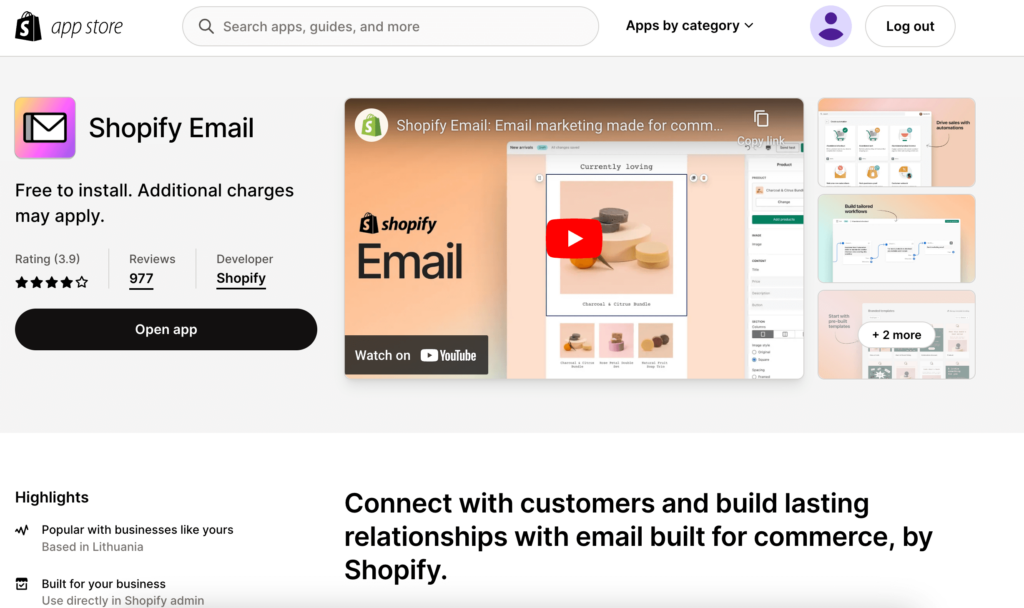
Both Shopify Email and Mailchimp offer an easy signup process. Shopify Email is part of the Shopify ecosystem. It acts like an add-on. So, there’s no separate signup process. Mailchimp’s signup process is relatively easy as well. A credit card is needed to start a free trial.
Changing the sender’s email address was extremely easy with Shopify Email. It is very beginner-friendly and ecommerce-focused. With Mailchimp, changing the sender’s email address was a bit of a hassle. This is due to the broad functionality of the tool. Mailchimp has many features, and it isn’t easy to find everything immediately.
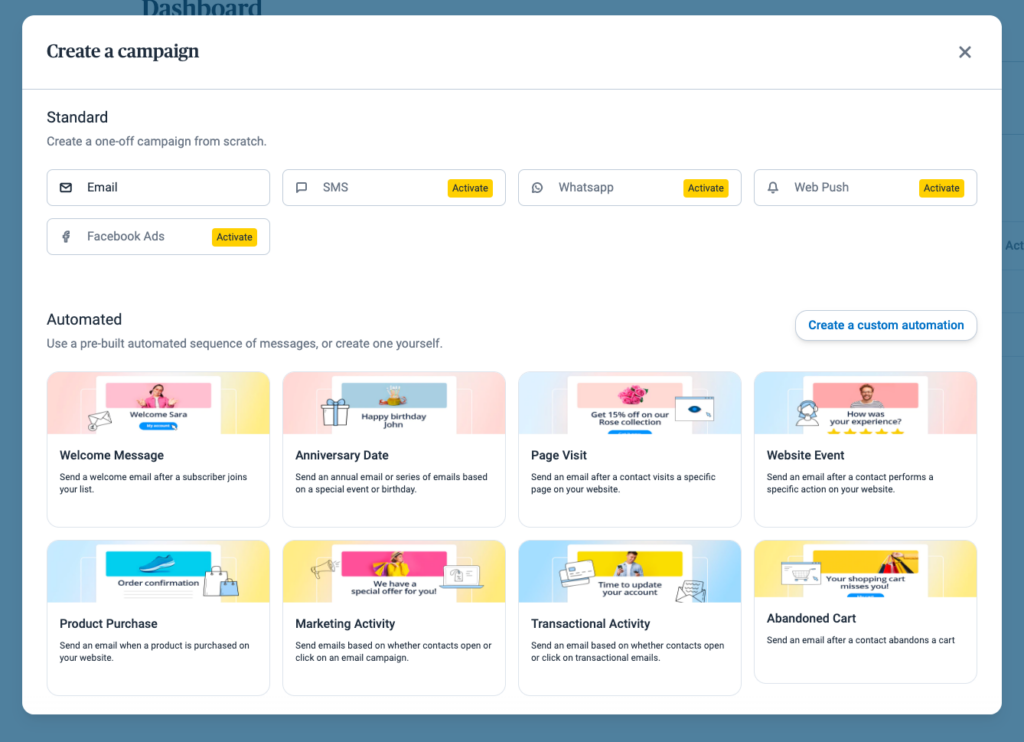
However, the navigation in Mailchimp was straightforward. The design is clear, and you get a checklist to help you get your account ready.
On the other hand, Shopify Email has few functions. Easy to locate and understand.
The downside of Shopify Email is its approachability. It is for Shopify merchants only. Meanwhile, Mailchimp’s wide range of functionality makes some things difficult to find.
This round is a tie. Shopify Email is easier to set up than Mailchimp. But, it is constrained to Shopify sellers only. This limitation gives Mailchimp a decisive edge.
Building an email campaign
Mailchimp or Shopify Email: which tool is better for building an email campaign? Mailchimp’s email campaign wizard is straightforward, intuitive, and clear—the same with Shopify Email. You can easily personalize the subject line and preheader in both tools.
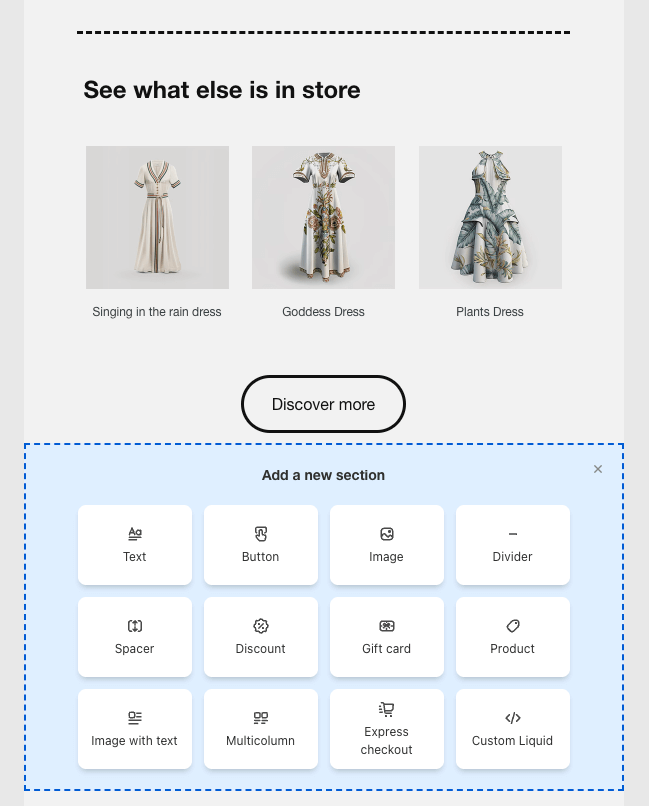
We found the email builder in Shopify Email to be very user-friendly and intuitive. It comes with all the standard content blocks. It even comes with discounts, gift cards, and other product elements. You can easily select the products and add them to your email automatically.
Mailchimp comes with two email builders–classic and a new builder. Both are very easy to use and have good functionality.
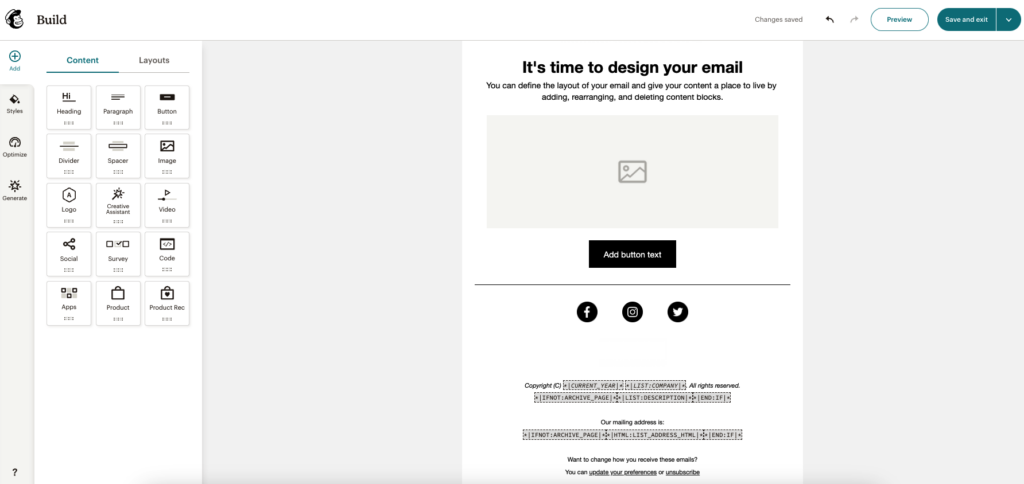
Mailchimp requires you to insert a logo during the setup process. But you can always change it later in the content section. This is very easy to do. However, removing the Mailchimp tag from the footer was tiresome.
In contrast, changing the logo, adding elements, and removing them were very smooth processes with Shopify Email.
Shopify Email also comes with 33 beautiful-looking email templates. The templates are grouped into the following categories:
- Announcements
- Holidays and occasions
- Newsletters
- Product highlights
- Promotions
The free templates in Mailchimp are basic, but the paid plans offer attractive and modern email templates.
While all email types are available in Mailchimp, Shopify Email offers a more limited selection. You can send a regular email campaign and email automation with Shopify Email. There are no A/B testing or RSS campaigns in Shopify Email.
Despite this, personalization is available and accessible with Shopify Email. You can easily personalize subject lines, preheaders, and the copy in your email.
In Mailchimp, on top of standard personalization functions, a dynamic content block allows even deeper personalization. The dynamic content block is one Mailchimp feature missing in Shopify Email.
Also, Mailchimp offers 25 free inbox previews on different devices through integration with Litmus. If you need more than 25 previews, you must pay extra for them in Litmus.
A downside of Mailchimp is email scheduling which is available only for paying customers.
Although Shopify has more accessible email templates, Mailchimp offers a more robust email campaign builder with more features and flexibility for merchants.
Marketing automation
Here, we will figure out which tool has the best marketing automation capabilities: Shopify Email or Mailchimp.

In Shopify Email, the automation part is intuitive and easy to use. The course gives off the impression that it is dedicated to email beginners. The platform offers a limited list of prebuilt, ready-to-use automation workflows, which can significantly help those just starting their marketing automation journey. But for more experienced users, it might look quite limited.
Workflows available include:
- Back-in-stock email
- Web push notification (for special product releases)
- Post-purchase up-sell email or SMS
- Abandoned checkout
- Abandoned cart
- Abandoned product browse
- Welcome email
- Welcome series
- Post-purchase thank-you email
- First-purchase upsell
- Customer win-back email
In Shopify Email, there are no natively integrated additional marketing channels. While it’s possible to integrate push notifications or SMS, you’d need to install and pay for additional apps.
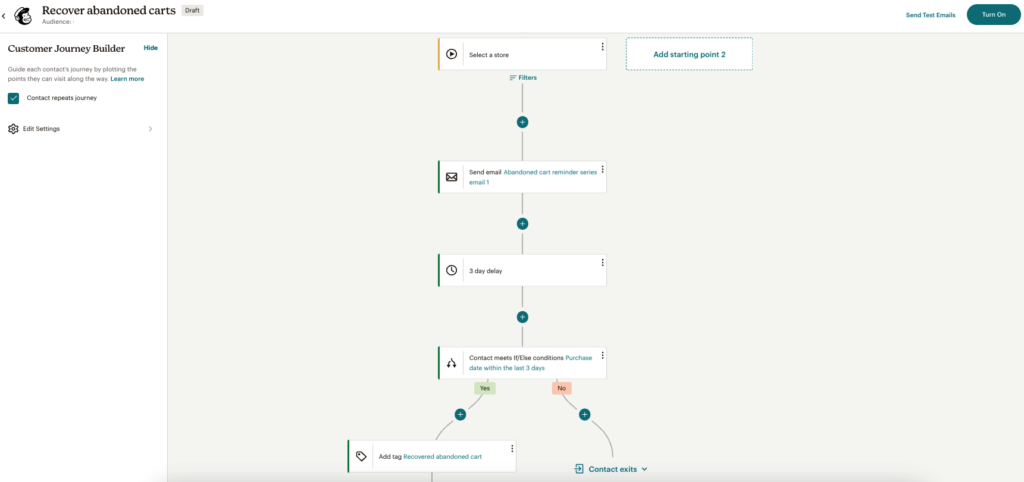
Meanwhile, Mailchimp’s automation is pretty easy to use as well. The product offers 70+ prebuilt customer journey templates, including various social media channels and emails. However, only the workflow structure is ready; in most cases, you must add the content yourself.
In Mailchimp, you can easily integrate social media into your workflows. And for SMS and other channels, you will have to pay extra and integrate 3rd party tools.
Mailchimp is the winner of this round. It provides more prebuilt workflows and a more comprehensive range of functionality.
Signup forms and landing pages
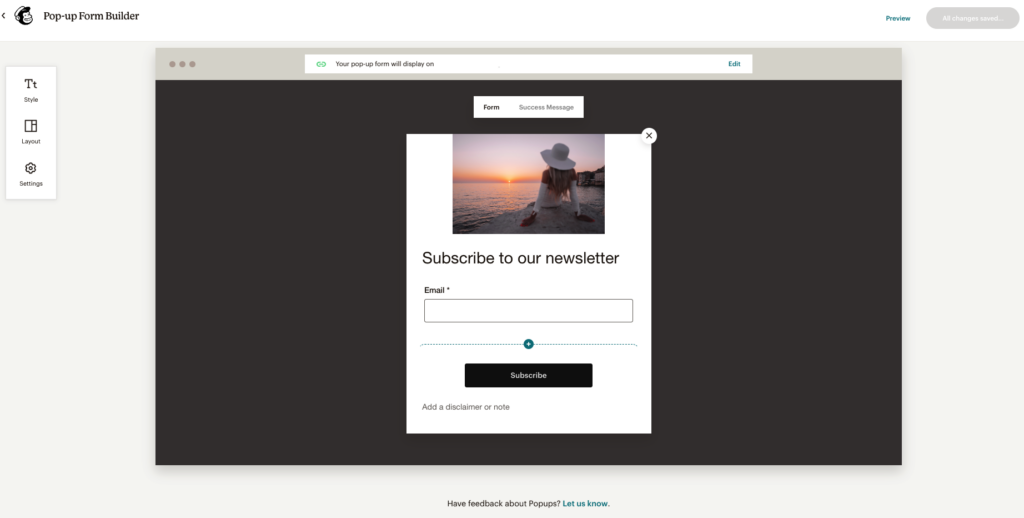
Mailchimp doesn’t offer ready-to-use signup forms and an extended library of beautiful templates. The signup form builder provides a single layout that can be easily modified and adapted to your brand needs.
Analytics for signup form performance are available, allowing you to access standard data such as signups and conversion rates.
Shopify Email doesn’t offer signup forms at all. For list-building needs, you will have to look for a different solution.
Landing pages also need to be added to Shopify Email. Meanwhile, Mailchimp provides a comprehensive landing page builder with 9+ templates. The landing page templates are straightforward to customize.
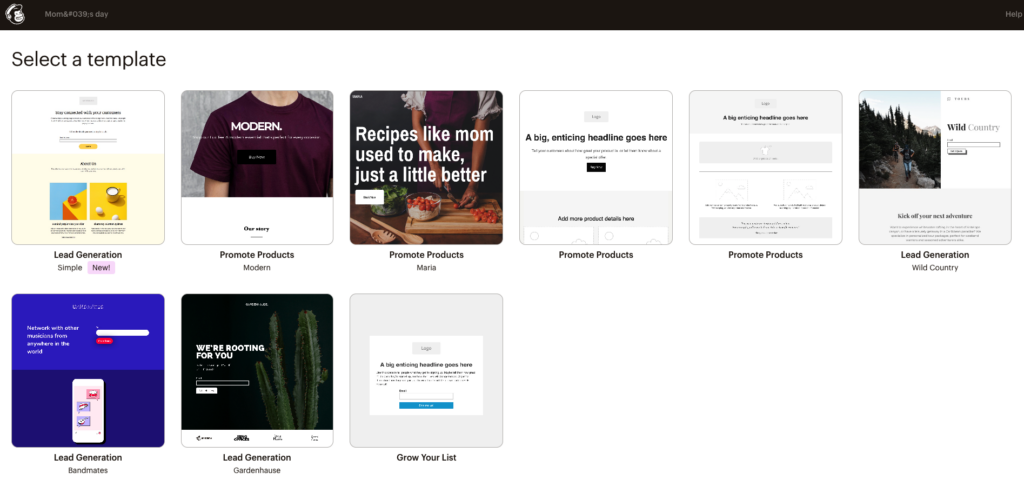
Regarding contact list management, Mailchimp makes it straightforward. You can easily tag and segment subscribers. The only downside is Mailchimp charges for contact duplicates, unsubscribes, and inactive contacts.
Additionally, Mailchimp only allows one popup at a time. This means you cannot combine an immediate popup with exit-intent or personalized popups for different customers.
However, these limitations don’t significantly harm Mailchimp’s position in this section, as list building is outside Shopify Email’s scope.
Mailchimp is the clear winner of this round. Shopify Email doesn’t offer signup forms or landing pages.
Segmentation
Shopify Email vs Mailchimp, how do their segmentation features compare? You’ll find out in this section.
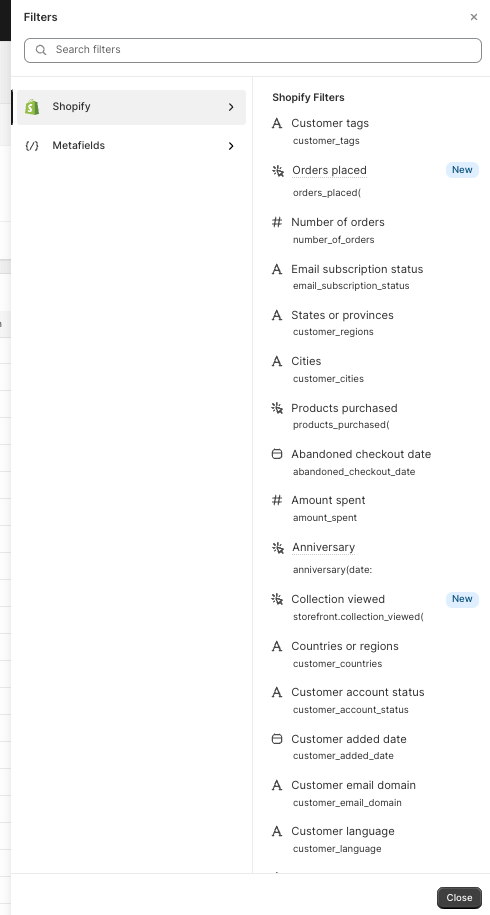
Regarding segmentation, Shopify Email stands out. This is primarily due to the main Shopify segmentation part used for Shopify email needs as well. Merchants can reuse the same segments and all the data collected in their stores. This is a highly convenient feature. Additionally, Shopify offers several prebuilt segments including:
- Customers who have made at least one purchase
- Email subscribers
- Customers who have abandoned their carts in the last 30 days
- Customers who have made more than one purchase
- Customers who have not made any purchases
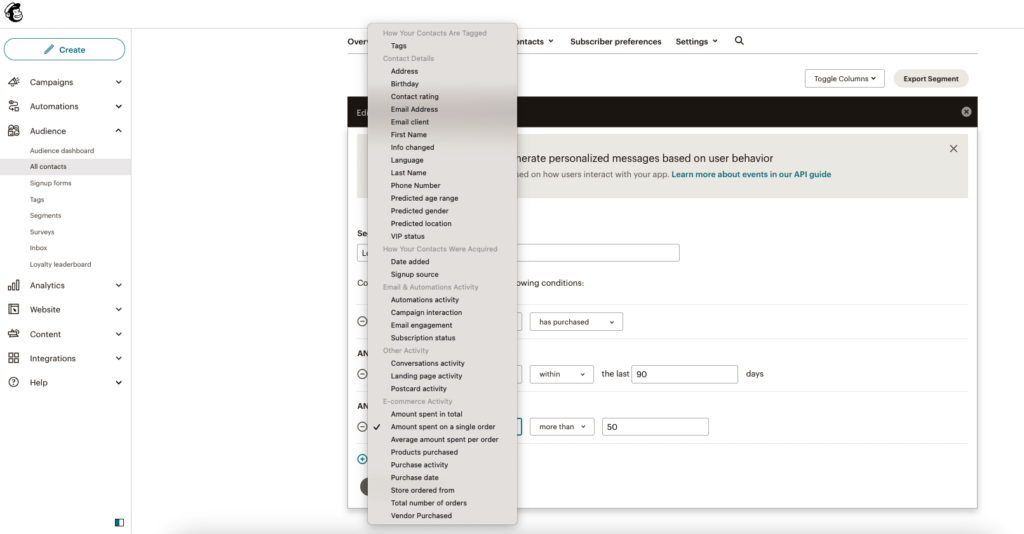
On the other hand, Mailchimp offers robust segmentation capabilities but provides only a limited number of pre-made audiences. As a result, you’ll need to create your own customer segments.
Shopify Email is the clear winner of this round.
Analytics
Mailchimp provides a wide range of analytics. However, the ecommerce reports are less robust than other ecommerce-focused platforms offer. Some of the metrics it tracks include the following:
- Opens
- Clicks
- Social media engagement
- Landing page engagement rate
- Campaign revenue
- You can see whether someone forwarded your campaign
- Whether those forwards were opened
- Geolocation reports, etc.
Comparative reports can also be precious but only available to premium plan users.
On the other hand, we could see fundamental reports on Shopify Email.
The tool provides analytics on:
- Total email sends
- Click-through-rate
- Sales attributed to email
- Automation series
In-depth insights like location, device, heatmaps and more were missing.
Mailchimp is the winner of this round. It offers a wider range of analytics than Shopify Email.
Customer support
Shopify Email’s customer support is the same as the general Shopify platform support. However, there is no live chat widget on the Shopify website, making contacting support inconvenient. Several do-it-yourself articles exist on the knowledge base.
In contrast, Mailchimp’s customer support depends on the plan you choose. Free users only have email support for the first 30 days, while paid customers have 24/7 email and chat support. Premium plan users can also call for help and receive priority.
During our testing, the live chat support was quick and efficient. The chatbot immediately transferred the conversation to a live agent, who resolved the query within 2-3 minutes.
In conclusion, while some Shopify Email customers gave poor reviews on the app store, our tests didn’t reveal any problems with Mailchimp support.
While Mailchimp’s free plan doesn’t offer one-on-one assistance after the first 30 days, it does provide a wealth of other helpful resources. Mailchimp offers video tutorials and other written support materials.
Additionally, there are multiple videos on YouTube in different languages. Overall, Mailchimp provides thoughtful, educational, and valuable resources.
Mailchimp is the winner of this round. It has more support options and a more extensive knowledge base.
Integrations
Shopify Email or Mailchimp? Which tool wins regarding integrations?
With Shopify Email, you can easily use any integration available on Shopify. This is good because it gives you more flexibility in using email features.
For example, you could integrate Shopify Email with your CRM to keep track of customer interactions or incorporate it with an SMS platform to send targeted texts to your customers.
On the flip side, Mailchimp’s integrations run to their hundreds. An extensive range of tools is supported.
This round is a tie.
Compatibility with other marketing channels
Shopify Email doesn’t have the native functionality of different channels, but you can use any other applications from the Shopify ecosystem to implement your marketing strategy. The only thing is that you will have to pay for them extra.
In contrast, Mailchimp connects directly with marketing channels such as Facebook, Google Analytics, and Instagram. SMS and push notifications are missing but you can get them via integrations for extra charge.
Mailchimp is the winner of this round.
Price Comparison
Price is often a top factor when choosing an email marketing service. To round off this Mailchimp vs Shopify Email debate, we’ll look at the pricing for each tool and how they compare.
Free plans comparison
Both Shopify Email and Mailchimp offer free plans.
Mailchimp’s free plan limits users to sending 1,000 emails per month and 500 subscribers. Additionally, only a few basic email layouts are available. The free plan doesn’t include other features such as A/B testing, email scheduling, and prebuilt customer journeys.
In contrast, Shopify Email is free for 10,000 emails per month. Plus, there’s no monthly or annual commitment. You get all of Shopify Emails’ best features on the free plan without restriction. Automations count towards your 10,000 free emails per calendar month. Abandoned checkout automation isn’t counted and is always free of charge.
All in all, Shopify Email has one of the best free plans we’ve seen.
Paid plans comparison
Mailchimp offers three paid plans including:
- Essentials
- Standard
- Premium
From 100,000 subscribers and above, you outgrow the Essentials plan and move on to higher-tier plans.
With Shopify Email, you only pay for what you use. After your free 10,000 emails per month, it’s $1 per 1,000 emails sent. Or $0.001 per email.
After your first 300,000 emails, you only pay $0.65 per 1,000 emails. When you send up to 750,000 emails, you only pay $0.55 per 1,000 emails. In essence, Shopify Email gets cheaper as you send more emails.
Summary - Which one wins?
Before we crown the final winner, here’s a quick rundown of all we’ve discussed in this comparison:
3.4
4.1
Paying for email sends:
- Up to 10,000 emails free
- $1 USD per 1,000 emails above 10,000 emails
- $0.65 USD per 1,000 emails above 300,000 emails
- $0.55 USD per 1,000 emails above 750,000 emails
On the Essentials plan:
- 1,000 subscribers — $13
- 5,000 subscribers — $69
- 10,000 subscribers — $100
- 50,000 subscribers — $350
- 100,000 subscribers — N/A
- 10,000 emails free every month
- Checkout abandonment
- Automated emails
- Free email templates
- 1000 email sends per month
- 500 subscribers
- Basic segmentation
- Basic templates
- Popup forms
- Landing pages
- Basic reports
- Support for first 30 days
- Very easy to use
- Clear navigation
- Nice designs
- Free automations
- Copy-ready emails
- Shopify segmentation
- Very wide range of features
- Lots of integrations
- User friendly
- Limited to Shopify users
- Limited reporting
- No signup forms
- Extra channels for extra pay
- Mailchimp charges for duplicate email addresses
- Free plan is very limited
- Paid plans get expensive quickly
- Email marketing beginners
- Small Shopify merchants
- Ecommerce beginners
- Solopreneurs
- Startups
- Bloggers
- Non-profit organizations
Established ecommerce businesses
Ecommerce stores that are in their active growth stage
Shopify Email vs Mailchimp: Mailchimp has more features, can integrate with more marketing channels, and offers stellar landing pages.
Shopify Email, despite its reasonable pricing, is more restricted. However, early-stage Shopify merchants may find its lightning-fast setup process a worthwhile trade-off.
If you are looking for email marketing solutions for ecommerce businesses, check ecommerce-focused platforms like Getresponse or Omnisend.
Read full reviews
Related picks for you
Our team strives to be accurate and unbiased in reviewing email tools. However, we recognize that mistakes can happen, and it’s essential for us to stay up to date. If you come across any errors or things that need to be reviewed again, please let us know.





Leave a Reply